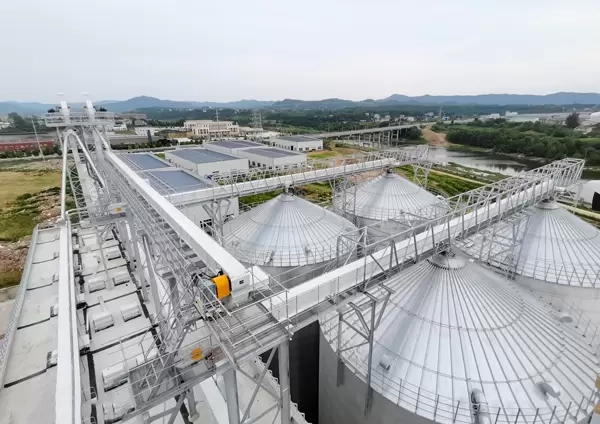Poultry feed production line is an indispensable part of modern breeding industry. Its emergence has greatly improved the production efficiency and quality of feed, and provided strong support for the development of poultry breeding industry. This article will introduce the production process of poultry feed production line in detail.
The main raw materials of poultry feed include corn, soybean meal, grain by-products, etc. The quality of raw materials must be ensured when purchasing. After the raw materials arrive, they are unloaded through the automated unloading system and stored in special warehouses or silos according to their types. These facilities usually have moisture-proof and insect-proof functions to ensure that the quality of raw materials is not affected.
Pretreatment mainly includes cleaning, crushing, mixing and other steps. First, the metal impurities and stones in the raw materials are removed by magnetic separation and screening. Then, the large pieces of materials are crushed into a size suitable for granulation using a feed grinder. After grinding, the next step is the mixing process. The purpose of mixing is to mix various raw materials together according to a certain formula ratio to ensure the balance of various nutrients in the feed. The mixing process is usually carried out by a feed mixer, which fully mixes the raw materials by rotating and stirring. Next, the ingredients are accurately batched according to the recipe requirements. The use of an automatic batching system can greatly improve the accuracy and efficiency of batching.

Conditioning refers to adjusting the humidity and temperature of the material by adding water, steam, etc. to make it suitable for granulation. This process has a significant impact on the quality of the final feed and animal digestion and absorption. For example, studies have shown that proper conditioning can improve the digestibility of starch in the feed. After mixing is completed, the next step is granulation. The purpose of granulation is to make the mixed feed slurry into granules by extrusion and cutting. This process is usually carried out using a feed granulator. By adjusting the pressure of the machine and the aperture of the mold, feed particles of different sizes can be produced.
After granulation is completed, the next step is the drying process. The purpose of drying is to evaporate the moisture in the feed particles to improve the preservation and stability of the feed. The drying process is usually carried out using a feed dryer, which evaporates the moisture in the feed particles by heating and ventilation. Subsequently, the oversized or undersized particles that do not meet the specifications are separated by a vibrating screen or other grading equipment to ensure the uniformity of the feed particles.
The dried feed pellets enter the automatic packaging machine for weighing and packaging. The packaging materials should be selected from materials with good air permeability and strong moisture resistance to ensure the stable quality of the feed during storage and transportation. The finished feed should be stored in a dry and ventilated environment to avoid direct sunlight and rain.
Quality control is an indispensable link in the entire production process. From the entry of raw materials into the factory to the delivery of finished products, each link should have strict quality inspection standards. For example, the nutritional content of finished feed needs to be regularly sampled to ensure that it meets the feeding needs. In addition, an efficient logistics system can ensure that the feed is delivered to the farmers in a timely manner, reducing storage time and costs.
Every link of the poultry feed production line is carefully designed and strictly controlled. From the selection of raw materials to the packaging of finished feed, these links are interconnected, and each link plays a vital role. Only through scientific production processes and strict quality control can high-quality poultry feed be produced, providing strong support for the development of the poultry farming industry.
As poultry feed production line manufacturers, we are committed to providing high-quality and efficient feed production line solutions. We have advanced technology and equipment, as well as an experienced team, and are able to customize the design and manufacture of poultry feed production lines of various sizes according to customer needs.